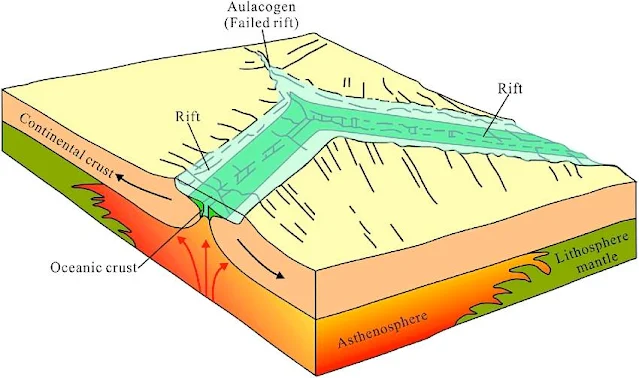What is Aulacogen?
An aulacogen is a failed arm of a triple junction of a plate tectonics rift system. A triple junction beneath a continental plate initiates a three way breakup of the continental plate.
As the continental break-up develops one of the three spreading ridges typically fails or stops spreading. The resulting failed rift is called an aulacogen and becomes a filled graben system within the continent.
The term "aulacogen" is derived from the Greek aulax (furrow) and was suggested by the Soviet geologist Nicholas Shatski in 1946.
Formation of Aulacogens
There are two main ways aulacogens form:
Triple Junctions: When three tectonic plates meet, a triple junction can form. If two plates move away from each other, but the third remains stationary, the rift associated with this junction may fail, leaving behind an aulacogen.
Divergent Boundaries: Sometimes, even along a classic divergent boundary where two plates move apart, rifting can be uneven. One arm of the rift may progress, forming an ocean, while the other arm stalls and becomes an aulacogen.
The crust in an aulacogen region remains weakened by previous rifting activity and thus seismic activity and, occasionally, volcanic activity may re-occur subsequently from time to time. As aulacogens remain places of weakness, given the appropriate conditions, they can reactivate into active rift valleys again, as had happened to the Ottawa-Bonnechere Graben in Ontario and Quebec, Canada, an ancient aulacogen that reactivated during the breakup of Pangaea.
 |
| Diagram of an aulacogen or a failed rift. |
Aulacogen Key features
Normal faults: Aulacogens are bounded by normal faults, where the rocks have moved down relative to the surrounding area. These faults create the characteristic deep valley shape.
Sedimentary fill: Over time, aulacogens fill with sediments eroded from the surrounding mountains or deposited by rivers and lakes. These sediments can hold valuable resources like oil and gas.
Seismic activity: Though not actively rifting anymore, aulacogens can still experience occasional earthquakes and volcanic activity due to the weakened crust.
Examples of Aulacogens
The Mississippi embayment with the associated New Madrid Seismic Zone is an example of an ancient aulacogen that dates back to the breakup of the ancient continent, Rodinia. This ancient rift was the site of extreme earthquakes in the early 19th century in the region.
The Southern Oklahoma Aulacogen, exposed in the Wichita Mountains, is an Eocambrian rift system formed as a product of intracontinetal rifting during the breakup of Pannotia. The Rio Grande Rift is another example. Located on the Southwestern European margin (offshore Portugal) is another abandoned rift, the Lusitanian Basin, that evolved at the same time as the Canadian Grand Banks region, where the Hibernia Oil Field is located.
Abandoned rift basins that have been uplifted and exposed onshore, like the Lusitanian Basin, are important analogues of deep-sea basins located on conjugated margins of ancient rift axes.









